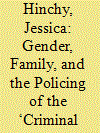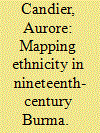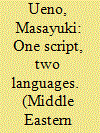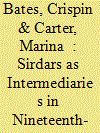|
|
|
Sort Order |
|
|
|
Items / Page
|
|
|
|
|
|
|
| Srl | Item |
| 1 |
ID:
174137


|
|
|
|
|
| Summary/Abstract |
In the South Asian setting, the fields of gender history and family history are still predominantly concerned with relatively elite social groups. Few studies have examined issues of gender and the family in the history of Dalit, low-caste, and socially marginalized communities, especially those that were labelled ‘criminal tribes’ from the mid-nineteenth century on. This article explores the ways in which gender patterned criminalized communities’ experiences of everyday colonial governance under Part I of the 1871 Criminal Tribes Act (CTA) in the first two decades that it was enforced in northern India. In this early period, the colonial government did not closely regulate marriage practices, domestic arrangements, or the gendered organization of labour within communities categorized as ‘criminal tribes’. Nevertheless, notions of sexuality and gender underlay colonial knowledge of the ‘criminal tribes’, which emerged in dialogue with middle-class Indian gender and caste politics. Moreover, the family unit was the central target of the CTA surveillance and policing regime, which aimed to produce ‘industrious’ families. Officially endorsed forms of labour had complex implications for criminalized communities in the context of North Indian gender norms and strategies of social mobility. Gender power dynamics also shaped criminalized peoples’ interpersonal, embodied interactions with British and Indian colonial officials on an everyday basis. Meanwhile, different forms of leverage and evasion were open to men and women to cope with their criminalization and so the colonial state was experienced in highly gendered ways.
|
|
|
|
|
|
|
|
|
|
|
|
|
|
|
|
| 2 |
ID:
168574


|
|
|
|
|
| Summary/Abstract |
Successive wars and the establishment of a border between the kingdom of Burma and British India in the nineteenth century challenged Burmese conceptions of sovereignty and political space. This essay investigates how European, and more specifically Anglo-American, notions of race, nation, and consular protection to nationals, progressively informed the Burmese concepts of ‘categories of people’ (lumyo) and ‘subject’ (kyun). First, I present the semantic evolution of these concepts in the 1820s–1830s, following the annexation of the western Burmese province of Arakan by British India in 1824. Then, I argue that the Burmese concept of lumyo was progressively associated with the European concept of ‘nations’ in the 1850s–1860s, following the annexation of Lower Burma in 1852. Finally, I uncover developments in the 1870s, when British consular protection extended to several freshly categorised ‘nations’, such as Shan, Karenni, and Kachin.
|
|
|
|
|
|
|
|
|
|
|
|
|
|
|
|
| 3 |
ID:
146797


|
|
|
|
|
| Summary/Abstract |
This article focuses on the publications of Garabed Panosian and examines the extent of readership achieved by the Armeno-Turkish newspapers in the nineteenth-century Ottoman Empire. It specifically focuses on the linguistic, social, and political circumstances in which his newspapers were read. The readership of Panosian's newspapers was not only limited to Turkish monolingual Armenians but also extended to Armenian--Turkish bilingual Armenians. Moreover, his newspapers, along with other Armeno-Turkish materials, gained a non-Armenian readership. Thus, Panosian was able to use his newspapers to display the allegiance of Armenians to the Ottoman Empire, aiming at a favourable evaluation from government circles. Besides being a tool to reach out to Turkish monolinguals, Armeno-Turkish newspapers were also rich products of the culture of bilingualism and a medium shared by religiously diverse people. Thus, examining Armeno-Turkish materials elucidates the pluralistic society of the late Ottoman Empire.
|
|
|
|
|
|
|
|
|
|
|
|
|
|
|
|
| 4 |
ID:
151865


|
|
|
|
|
| Summary/Abstract |
In 1819, the American Board of Commissioners for Foreign Missions (ABCFM) began a mission in the Middle East. Though initially the missionaries sought to convert Muslims and Jews to the Christian faith, they soon turned to revitalizing their co-religionists. This puzzling situation of Christians proselytizing other Christians occurred because the two groups of Christians, American and Middle Eastern, held very different cultural and political notions of what that identity meant. In the end, the American mission remained minimally effective at conversion but influential in its secular goals of educating, furthering religious freedom, and modernization. Counter-intuitively, the missionaries’ religious proselytizing became implicated in a kind of secularization.
|
|
|
|
|
|
|
|
|
|
|
|
|
|
|
|
| 5 |
ID:
152623


|
|
|
|
|
| Summary/Abstract |
The sirdar (also termed sardar and jobber in Indian historiography)—foreman, recruiter, at once a labour leader and an important intermediary figure for the employers of labour both in India and in the sugar colonies—is reassessed in this article. Tithankar Roy's thoughtful 2007 article looked at how the sirdars’ multiple roles represent an incorporation of traditional authority in a modern setting, giving rise to certain contradictions. In 2010 Samita Sen, conversely, developed Rajnarayan Chandavarkar's argument about the use of labour intermediaries in colonial India to reveal how, in the case of the Assam tea plantations, the nexus between contractors and sirdars belies the ‘benign’ role often accorded to the intermediary within narratives from the tea industry. This article provides examples from the overseas labour destinations in the Indian Ocean region, particularly Mauritius, to further develop and nuance the debate, through an assessment of the complexity of sirdari roles in the colonial Indian labour diaspora.
|
|
|
|
|
|
|
|
|
|
|
|
|
|
|
|
|
|
|
|
|